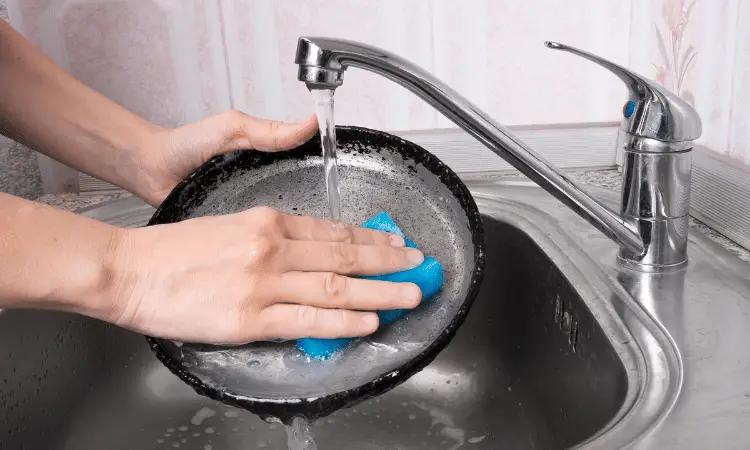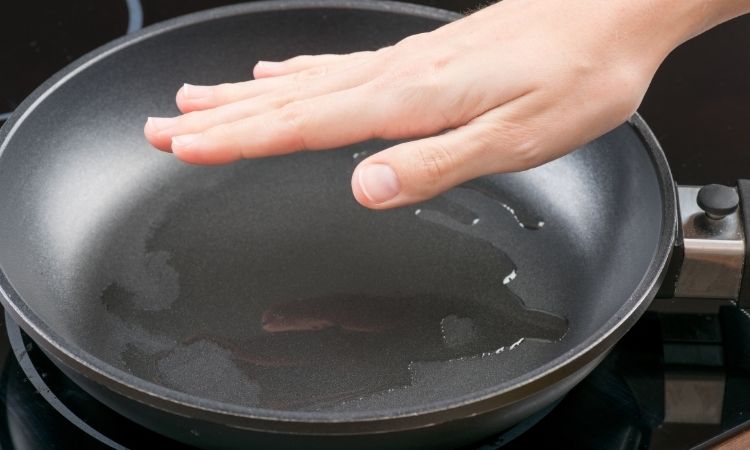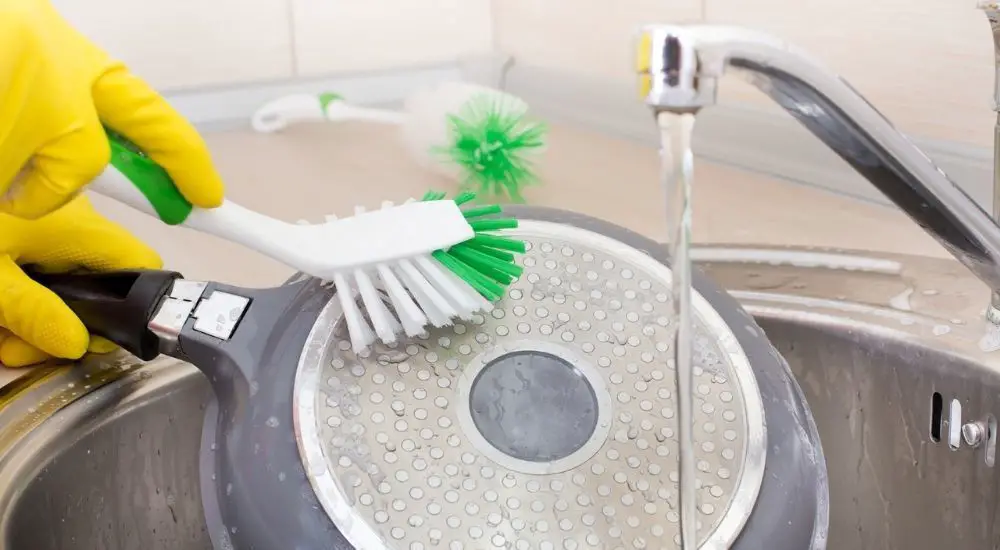
It is an absolute joy waiting in anticipation of a new order. If you are a cooking enthusiast, you will know that feeling. When you have cooked, seared, fried, and sauteed so many recipes on the age-old pans you have been using since you’ve been married, and now a brand new set of stainless steel cookware is to arrive at your door – how enthralling!
But as soon as they reach you, and you like an excited child unwrapping his Christmas gift vigorously, take it all apart piece by piece and lay them out – you feel a sudden aching. How bright and shiny, they appear in mint condition. I remember feeling this way when buying new shoes and wondering all the dirt and mud it would soon dress in and take away that pristine look out of it. Likewise, your marvelous pots and pans will, at one point, grow spots, stubborn stains, and no longer carry that shiny appearance. After numerous uses, it is far too normal to expect these damages.
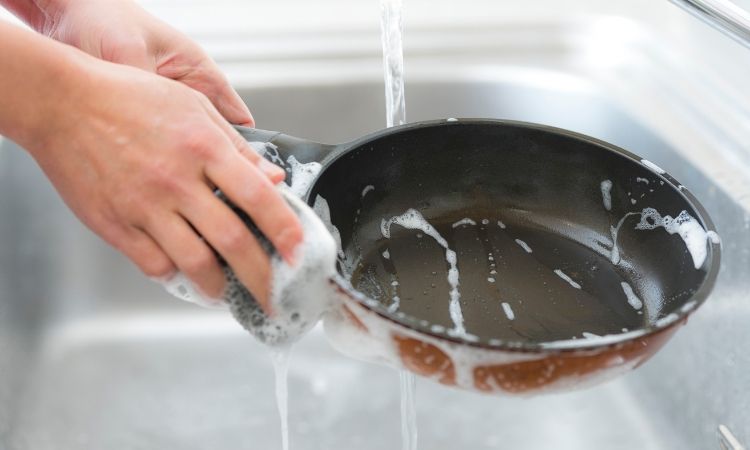 But fear not! Where there is a problem, we always find a worthy solution. Let us guide you in maintaining and taking care of your valuable cookware from the regular discoloration and damage.
But fear not! Where there is a problem, we always find a worthy solution. Let us guide you in maintaining and taking care of your valuable cookware from the regular discoloration and damage.
How to Clean Calphalon Pans
Dry Hard
Those rather unpleasant water spots that form on your pans over time, they really are annoying, aren’t they? Well, if you don’t want that unpleasant sight, get to drying the stainless steel immediately after you notice them. But if you do come across those water spots after they have settled in onto the pans, then worry not, dampen the affected region, and use a soft sponge dipped in baking soda, scrub away, and rinse as usual.
Tell Your Cold Foods To Chill!
Cold food items are prone to sticking to your hot pan—the hot steel contracts when it comes in touch with a cooler temperature. Therefore, before cooking foods straight out of the refrigerator like fish, meat, and chicken, allow them to settle down at room temperature for 10 to 15 minutes. Use a soft piece of cloth or paper towel to rub off the excess moisture from the surface of the foods and then lay them out onto the pan.
Water Test For The Hotness
Is your pan ready to get going? Is it hot enough for the oil? To understand that here’s an easy water test that will save you the doubt: When your pan is past the water sizzling stage when it hits the surface, the water will not just settle idly. Add a negligible amount of water on the surface of your pre-heated pan. If your pan is perfectly pre-heated, the water right upon hitting the surface of the pan will form into a ball that will slide and glide across the surface. When this happens, you can be ensured that your pan’s surface is pre-heated just right.
Heat, Heat, Heat!
This is fundamental advice. Before every cooking session, you have to make sure you heat your pan before letting the oil roll in. Pour in the oil once the pan is hot enough and let the oil heat up. After the oil heats up, then add the food and start cooking. But why in that order, you may ask. It is because adding oil to a heated up pan forms a nonstick surface that prevents foods from sticking or becoming greasy. Let the oil heat up for some time. Once it is hot enough, you will notice it glisten, that is when you know it is the right time to add the food to start cooking. However, it is important to realize that stainless steel is highly effective at absorbing heat. Therefore, don’t rush the pre-heating process by using excessive heat or that will lead to overheating the pan and cooking burnt food.
When To Saltwater
Pitting corrosion is a common issue with pans. It occurs when you salt your water before boiling it. As a result, pits or small and irreparable holes form at the bottom of your pot or pan. It is necessary to note that when you salt the water for your pasta or mashed potatoes, only do it when the water is boiled properly.
Your Pan Doesn’t Like It Rough!
Refrain from using steel wool, hard-bristled scrubs, or anything coarse-grained when cleaning your pots and pans. Moreover, avoid using potent cleaning agents like bleach or household cleaners like dishwashing detergent. These cleaners and cleaning agents may seem like a smart option for getting rid of tough stains; nevertheless, they will damage your stainless steel coating and form scratches, cause the coating to peel or chip off and take away the overall glam of the appearance. Instead, go for mild dish soap, a lemon and water solution, white vinegar, olive oil, and soft sponges and dishcloths as cleaners for effective but safe performance.
Say No To Drastic Changes In Temperature
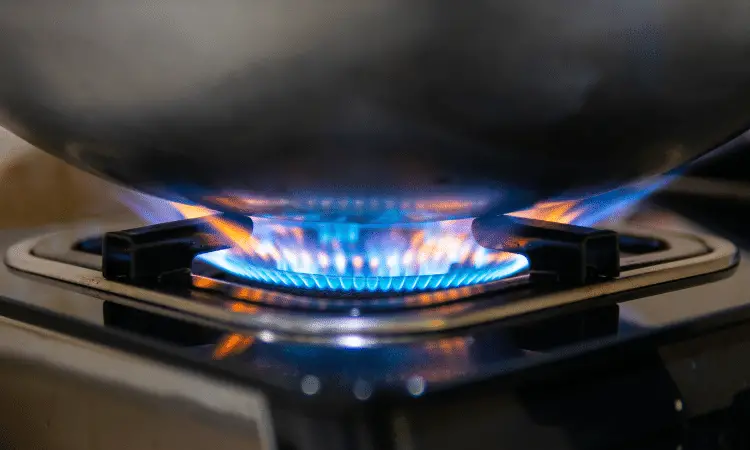
Drastic temperature changes are very damaging to your cookware. It results in the stainless steel warping that is also irreparable. Warped stainless steel cookware cooks food with uneven heat distribution – as a result, your pancake or poached egg may not be evenly heated or cooked properly. Therefore, it is essential to be cautious regarding temperature changes. Be careful when dipping your hot pan into cold dishwater immediately after cooking, or as mentioned earlier, throwing in cold foods directly onto a hot pan, and you’ll be fine.
Don’t Be Lazy!
Every time you use your cookware, wash them before and after each use. This way you create a healthy habit that will ensure quality is maintained and your dishes don’t pile up.
How to Restore Calphalon Pots and Pans
Cleaning Your Pans – The Lite Method
Now that we have caught up on numerous guidelines on taking proper care of your stainless steel pots and pans, it’s time we address the main course – the cleaning process. Cleaning your cookware is the only process that will ensure they have a longer lifespan and your kitchen looks neat. A neat kitchen without a piling mess is always an incentive to cook and work with a motivation unlike any other. Who likes to walk into a kitchen that looks like the bottom of your trashcan? Therefore, knowing how to clean and keep the mess at bay is very necessary if not the most. We now go into an in-depth read of cleaning your cookware for the standard mess.
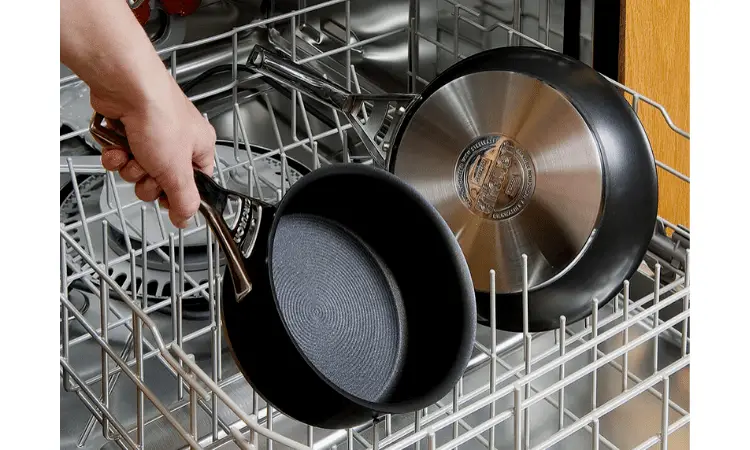
You can opt for dishwashing your pots and pans because stainless steel is dishwasher safe. Despite that, we prefer handwashing our pots and pans. Why? Because we can reach every nook and corner of our pots and pans using our hands, making sure no bits of dirt or grease is left sticking to the surfaces.
How do we get started? First, we use a paper towel to sweep off any excess oil, then we add warm water to deglaze the pan. This helps loosen any food residue like the brown grease sticking to the corners of the pan. However, you can always use a dish brush (but make sure it is not harsh on the surface) to scrub off any leftover residue. Once we have covered that ground, we allow the pans to cool off (because drastic temperature changes are bad!) and then soak it in hot water. Hot water is your best friend in ensuring all the food bits are loosened up and ready to be scraped out.
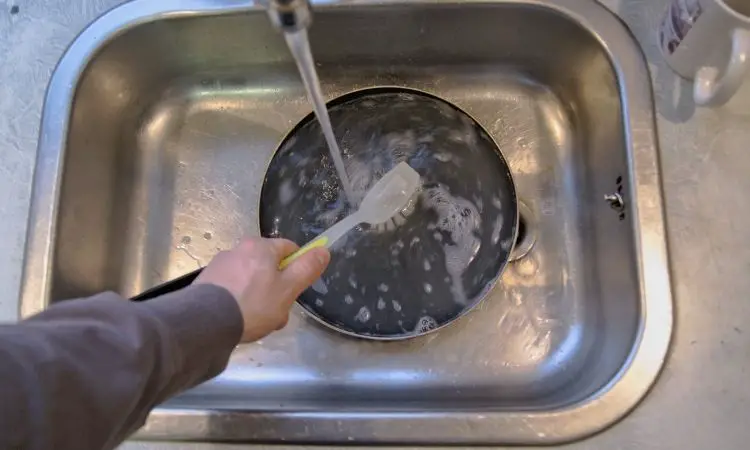 Now’s the fun part; once the grease loosens up after leaving the pan in the hot water for a few minutes, pick up a soft sponge and squirt out some dish soap on top of it. Use the scouring pad to scrub all around the pan, going inside and out in circular motions maintaining constant pressure (not too hard, not too gentle). Afterward, rinse the pan thoroughly with water and dry it out with a clean and soft cloth. Be careful not to use any harsh or abrasive cleaners like wire sponges to ensure no scratches form on the surface.
Now’s the fun part; once the grease loosens up after leaving the pan in the hot water for a few minutes, pick up a soft sponge and squirt out some dish soap on top of it. Use the scouring pad to scrub all around the pan, going inside and out in circular motions maintaining constant pressure (not too hard, not too gentle). Afterward, rinse the pan thoroughly with water and dry it out with a clean and soft cloth. Be careful not to use any harsh or abrasive cleaners like wire sponges to ensure no scratches form on the surface.
Seasoning Your Calphalon Pan – Heavy Duty
What do you do when mild dish soap and a soft sponge is not cutting it? When you notice baked-on layers of oil and blackened grease sticking to the crevices? When the regular effort of your hands is just not doing the job (entirely)? Fear not, for we have only the right methods for getting rid of those stubborn burns and toughened stains.
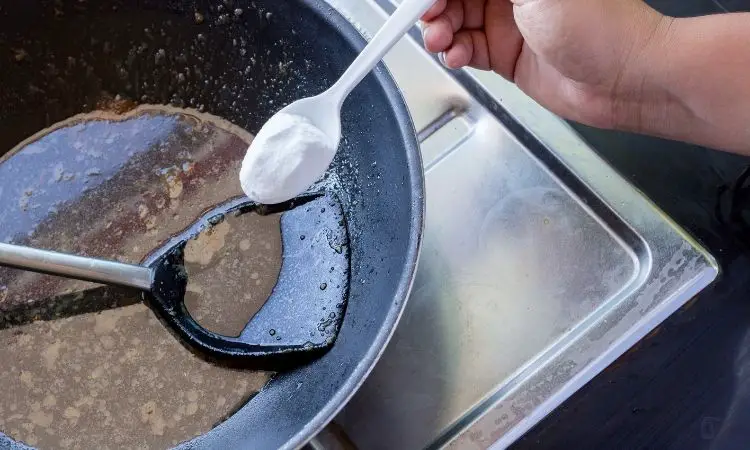
We will need stronger cleaning agents like the infamous Bar Keepers Friend, Murphy’s Oil Soap, Bon Ami, and the traditional baking soda for this part of the procedure. But we will go with the easiest one – plain baking soda. Firstly, it has been the way to go when cleaning kitchenware for time immemorial. It is highly accessible and economical. On the other hand, it doesn’t damage your stainless steel; unlike harsh cleaners like dishwasher detergent and oven cleaners that can peel the coating off even though they are appealing as an ‘easy solution’. Experts worldwide always advise us to avoid harsh chemicals like chlorine and bleach, and oven cleaners are no different. The damage from oven cleaners and such harsh substances is more than a few scratches you can get from hard-bristled brushes. They cause irreparable damage, forming small holes and pitting corrosion which later causes foods to stick and burns to form once the residue is heated up easily. Instead, we will give you three methods, all using baking soda, to provide you with satisfying results for all levels of stains.
Level#1 – Clean Burnt Calphalon Pans
Remember, procrastination in the kitchen is a big no-no. It is wise to get to cleaning your burnt and used calphalon pans and pots after cooking right away. It gives the stubborn stains lesser time to settle onto the surfaces. Create a small pool of water and baking soda at the bottom of your pan and let the baking soda feel right at home for a few minutes. Then scrub every nook and corner with a soft sponge gently and taking your time. Repeat the same process and allow the paste to settle in for longer if the stains don’t come off after one wash.
Level#2
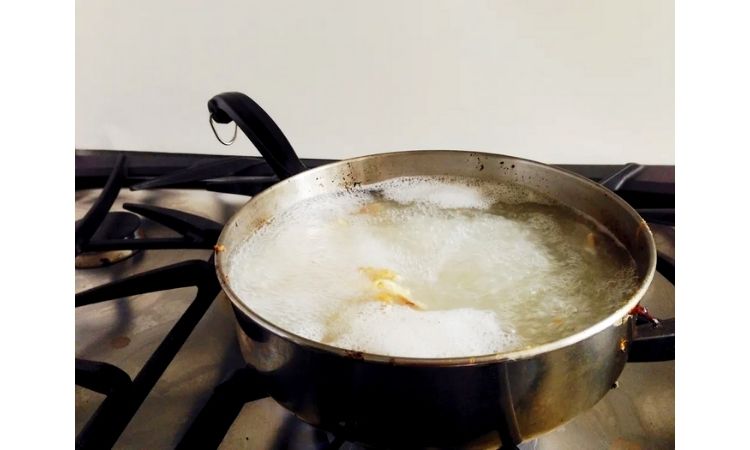
Sometimes, you need to take the game to the next level. This is for tougher stains and nasty bits of grease that climb up the sides of your pots and pans and no matter what, just won’t let go with one or two washes. Now is the time to boil the baking soda (sounds tough, right?). Add a generous amount of baking soda to the bottom of the pan and pour in a quarter of water (you may need more for a bigger pot or pan, use accordingly), then heat the mixture to a boil. As the mixture starts to boil and the water begins to evaporate, you will be left with strips of baking soda sticking to the corners of the pan that you are to scrub off. Step it up once all the water has evaporated by picking a scrubbing pad and go thoroughly cleaning all around the mess. Be careful and wear gloves or oven mitts as the pan will be hot.
Boss Level
The previous levels will not be effective in getting rid of years of accumulated crud. But there is a solution to this as well. This is not just boiling the baking soda, but the whole thing – boiling your pots and pans with baking soda! Sounds exciting, you bet. Cooking in the same cookware for years forms crud that took years to settle and therefore won’t leave just like that. To ensure you get rid of every last bit of the filth, that too with the least bit of effort – try this method.
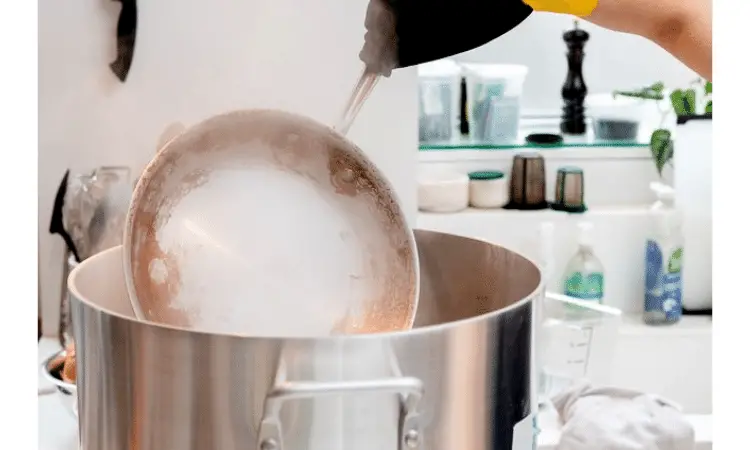
First, pick a large enough bowl or bucket to fit in the pots and pans because this is the ‘big league’. Fill the container with enough water that will sink the pots and pans and boil it. Now add the baking soda – a powerful amount of almost two cups of baking soda (or more according to the container’s size and the cookware in there). Place the pots and pans gently and in an organized fashion. Bring the heat to a mild level and let it cook for 10 to 15 minutes. Flip the pots and pans from time to time to ensure all sides are covered in the boil. In no time, the grease will start to fall off.
Afterward, turn the stove off, and using gloves carefully take the cookware out piece by piece. Sprinkle some more baking soda over the pots and pans and pour some water to create a foamy surface. Then go at it with a sponge and scrub every portion and crevice all while the pots and pans are hot. This way you will make sure all those years of crud are washed off and clear. Lastly, dry it off with a towel and let them cool on their own at room temperature.
Final Thoughts
Stainless steel cookware is durable and reliable. Their polished outlook also adds to the aesthetic of your kitchen. But remaining proactive and careful about the care they get is key to ensuring they give you the value for the investment you made. Therefore form a routine of cleaning the cookware set before and after use on a regular basis and read up on cleaning calphalon stainless steel caring for stainless steel cookware. The more knowledge you have regarding this topic, the more effective a job you will do. These guidelines will help you take your ‘clean & care’ routine to the next level and give your cookware a longer lifespan overall.

